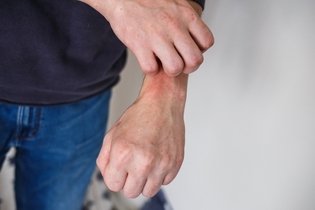A botfly is an insect of the Dermatobium hominis species of flies that is characterized by its gray color, black stripes on the thorax and a metallic blue abdomen. It often carries an infection that is transmitted to humans when the larva of the fly manages to enter the skin, even when the skin is intact, leading to the appearance of a painful wound with pus.
As soon as the first symptoms appear, it is important to consult with a dermatologist, an infectious disease specialist or a G.P. in order to confirm the diagnosis. Botfly removal is indicated to prevent worsening of symptoms and infection.
This type of fly is usually found in humid, mountainous areas such as some parts of Brazil and other tropical countries and, therefore, most people come into contact with them while traveling.

Botfly removal
Before removing the larva, it's important to verify whether it is already dead, as small fragments of the larva's body could be left inside the skin, making the removal much more difficult. This procedure should always be guided by a physician, but one of the ways of doing it at home is to put a piece of tape over the wound and leave it for about an hour. This will asphyxiate the larva to make removal easier.
After that, the tape should be removed and, on removal, it is necessary to check if the larva has also been removed with it. If not, extra pressure on the outside borders must be applied, to try and get it out. After removing the larva is important to treat the region with a antibiotic ointment, which can be prescribed by a doctor, to prevent further infection by bacteria.
If this is ineffective, the removal of the larva should be done by a doctor with the use of special tweezers. In more severe cases, it may be necessary to perform a minor surgery to cut the skin and widen the hole, allowing the larva to be removed.
Main symptoms
After the eggs are laid by the female botfly, the larvae hatch after about six days, and rapidly penetrate the skin, even when the skin is intact and healthy. They can cause some symptoms such as:
- Formation of wounds on the skin, with redness and slight swelling on the region;
- Release of a yellowish or bloody fluid from the sores on the skin;
- Sensation of something stirring under the skin;
- Pain or intense itching at the wound site.
Symptoms appear after the female fly deposits her eggs on the skin. After about 6 days, the larvae hatch from the eggs and quickly penetrate the skin.
Confirming a diagnosis
The diagnosis of a botfly is typically confirmed by a dermatologist or infectious disease specialist by assessing the signs and symptoms that the person presents with. The doctor will also take into account whether or not the person has traveled to a risk region.
In some cases, the doctor may recommend dermoscopy, which is a non-invasive method of evaluating the skin.
Prevention measures
Some of the best ways to avoid getting a botfly infection, especially when traveling to a tropical country, include:
- Closing all windows and doors after it gets dark;
- Using nets on the windows;
- Avoid having food or liquids accumulating indoors;
- Using mosquito repellent.
In addition, in tropical regions it is recommended to iron all clothing before dressing, especially if it has been sun drying, since the eggs of the fly may stick to the fabric.








